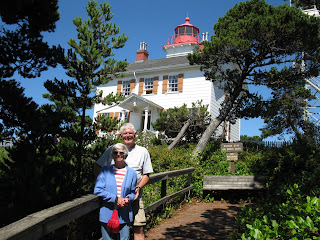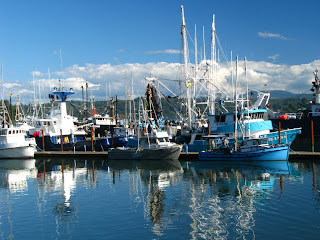Saturday, August 31, 2013
Newport Area
August 29, 2013 – Thursday
It rained much of the night and yet this morning. Since the trip to South Beach is only about 75 miles we waited for the rain to let up before breaking camp. It finally did about 10AM. It was foggy and raining most of the way there, so we didn’t stop in Lincoln City as planned. Guess we’ll come back on a nicer day. Highway 101 is narrow in areas with some surprisingly steep hills. We got checked in at South Beach State Park a little after 1PM. Fortunately the rain let up, but was replaced by a strong cold wind.
After we dried off and warmed up, we headed over to the Hatfield Marine Center, run by Oregon State University. This place has some great kid’s educational exhibits including a “touch me” tide pool area. They also have exhibits on various marine research activities. A couple of interesting ones were obtaining energy from ocean waves and batteries using microbacteria from the ocean. There was a hunk of dock that floated over here from Japan’s tsunami. It took a year to get here and was covered with plant and animal species foreign to the waters on this coast. Fearing these could be disruptive to the coastal environment here, there are very strict rules if you find tsunami debris. Since Japan’s nuclear plant got wiped out there is some concern about radioactive debris as well.
August 30, 2013 – Friday
Overnight the wind died down, but it was very cloudy and foggy this morning, so we headed to the Oregon Coast Aquarium, which is less than 2 miles from the campground. The popular animals were the sea otters and seals. The otters were real hams and would come right up to the glass barrier to show off. They have an underwater fish tunnel, popular in most aquariums today.
The weather cleared and the sun came out. When we had seen pretty much everything at the aquarium, we headed for the two lighthouses nearby. The Yaquina Bay Lighthouse is the second oldest on the Oregon Coast, built in 1871. This lighthouse is build into the keeper’s quarters, making it unique since most are built separately. It has been faithfully restored and recently reactivated mainly for smaller fishing and recreational boats. A picture follows.
The second lighthouse, Yaquina Head Lighthouse, is still in operation, so we could only climb the 115 steps to the lantern room, the very top is USGC property. At the top it was possible to see the 2 inch tall 1000 watt bulb used to power it. Its first order Fresnel lens projects the beam 20 miles; pretty amazing. Back in the day, 1873, they used 4 wicks fueled with refined lard oil. The park includes an interpretive center and tide pools at Cobble Beach. It is a BLM run property, so we used our NPS pass to get in free.
Cobble Beach was rated a good tide pool area. Low tide today was 2:30 PM at +2.5 ft, so there wasn’t much to see as we were late by about an hour and half. However, there were two other big problems. First, the “beach” is a big pile of 2 to 4 inch cobble stone. Try walking up and down hills on this stuff, its terrible. Second is Oregon’s version of fish-flies. They are the size of house flies and swam all over you. Their life cycle is about a week. Fortunately they don’t bite, but land and cling. The scenery was pretty neat.
Last was a stop in Newport’s historic fishing village where the commercial fishermen boats are docked. This place was bustling with activity as boats off loaded fish and then loaded them into semi-trucks for processing. Mixed into all this were shops and restaurants. Neat place and close to the campground, so we may be back for a longer visit. A picture follows.
Subscribe to:
Post Comments (Atom)






No comments:
Post a Comment